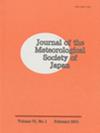Relationship between Sea Surface Temperature and Rainfall in the Philippines during the Asian Summer Monsoon
IF 2.4
4区 地球科学
Q3 METEOROLOGY & ATMOSPHERIC SCIENCES
引用次数: 6
Abstract
We offer a new perspective on a relationship between sea surface temper- 2 ature (SST) over the windward region of the Philippines and rainfall in 3 the western Philippines during the Asian summer monsoon season, which 4 has been known as the negative correlation, using observational daily SST, 5 rainfall, and atmospheric circulation datasets. This study focuses on the 6 local SST effect rather than the remote effect. A warmer local SST re- 7 sults in greater rainfall over the western Philippines under similar monsoon 8 westerlies conditions, particularly during moderate and relatively stronger 9 monsoon regimes. This result is obtained after selecting only the moderate 10 or relatively stronger monsoon days, because the positive effect of SST on 11 rainfall is masked by the apparent negative correlation between SST and 12 rainfall. The warmer SSTs being associated with less rainfall correspond 13 to weaker cooling by weaker monsoon westerlies and the cooler SSTs being 14 associated with more rainfall correspond to stronger cooling by stronger 15 monsoon westerlies. The cooler SSTs are the result of stronger monsoon 16 cooling and are not the cause of the greater rainfall, which is the appar- 17 ent statistical relationship. This also implies that the monsoon westerly is 18 the primary driver of the variation in rainfall in this region. We conclude that the local SST makes a positive contribution toward rainfall, although 20 it does not primarily control rainfall. This conclusion can be applicable to 21亚洲夏季风期间菲律宾海温与降水的关系
我们利用观测到的日海温、降水和大气环流数据集,对亚洲夏季风季节菲律宾迎风区海温(SST)与菲律宾西部降雨之间的负相关关系提供了一个新的视角。本研究侧重于局部海温效应,而非远程效应。在类似的季风西风带条件下,当地海温变暖导致菲律宾西部的降雨量增加,特别是在中等和相对较强的季风条件下。这一结果是在只选取了10个中等或相对较强的季风日之后得出的,因为海温对11降水的积极影响被海温与12降水的明显负相关所掩盖。较暖的海温与较少的雨量对应较弱的季风西风带造成较弱的降温;较冷的海温与较多的雨量对应较强的季风西风带造成较强的降温。较冷的海温是季风变冷的结果,而不是降雨增加的原因,这是表面-实际统计关系。这也意味着季风西风是该地区降雨变化的主要驱动因素。我们得出结论,当地海温对降雨有积极贡献,尽管它不是主要控制降雨。这个结论可以适用于21
本文章由计算机程序翻译,如有差异,请以英文原文为准。
求助全文
约1分钟内获得全文
求助全文
来源期刊
CiteScore
6.70
自引率
16.10%
发文量
56
审稿时长
3 months
期刊介绍:
JMSJ publishes Articles and Notes and Correspondence that report novel scientific discoveries or technical developments that advance understanding in meteorology and related sciences. The journal’s broad scope includes meteorological observations, modeling, data assimilation, analyses, global and regional climate research, satellite remote sensing, chemistry and transport, and dynamic meteorology including geophysical fluid dynamics. In particular, JMSJ welcomes papers related to Asian monsoons, climate and mesoscale models, and numerical weather forecasts. Insightful and well-structured original Review Articles that describe the advances and challenges in meteorology and related sciences are also welcome.
文献相关原料
| 公司名称 | 产品信息 | 采购帮参考价格 |
|---|

 求助内容:
求助内容: 应助结果提醒方式:
应助结果提醒方式:


